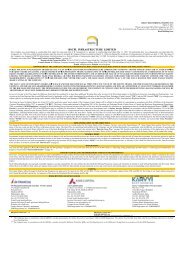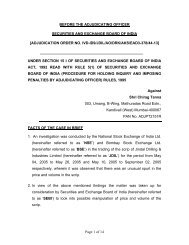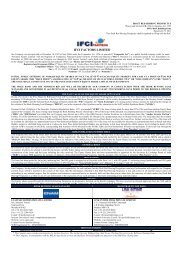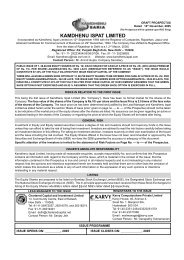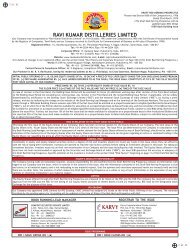sejal architectural glass limited - Securities and Exchange Board of ...
sejal architectural glass limited - Securities and Exchange Board of ...
sejal architectural glass limited - Securities and Exchange Board of ...
Create successful ePaper yourself
Turn your PDF publications into a flip-book with our unique Google optimized e-Paper software.
� Fused silica <strong>glass</strong> – Fused silica <strong>glass</strong> is a highly heat-shock resistant <strong>glass</strong> that consists<br />
entirely <strong>of</strong> silicon dioxide. It is used in laboratory <strong>glass</strong>ware <strong>and</strong> optical fibers. It consists <strong>of</strong><br />
a special borosilicate composition that has been made porous by chemical treatment.<br />
Uses <strong>of</strong> Glass<br />
� Flat <strong>glass</strong> is used chiefly in windows. It is also used in mirrors, room dividers <strong>and</strong> furniture.<br />
All flat <strong>glass</strong> is made in the form <strong>of</strong> flat sheets. But some <strong>of</strong> it, such as that used in<br />
automobile windshields, is re-heated <strong>and</strong> curved over moulds.<br />
� Glass containers are used for packaging <strong>of</strong> food, beverages, medicines, chemicals <strong>and</strong><br />
cosmetics. They are made from special <strong>glass</strong> formulas to make sure there will be no<br />
contamination or deterioration <strong>of</strong> blood plasma, serums, <strong>and</strong> chemicals stored in them.<br />
� Optical <strong>glass</strong> is used in eye<strong>glass</strong>es, microscopes, telescopes, camera lenses <strong>and</strong> other<br />
instruments for factories <strong>and</strong> laboratories. The raw materials used to make optical <strong>glass</strong><br />
must be pure. The care required for producing optical <strong>glass</strong> makes it expensive.<br />
� Fiber<strong>glass</strong> consists <strong>of</strong> fine but solid rods <strong>of</strong> <strong>glass</strong>, each <strong>of</strong> which may be less than one<br />
twentieth the width <strong>of</strong> a human hair. Glass fibres are loosely packed together in a woollike<br />
mass that can serve as heat insulation. They are also used like wool or cotton fibres to<br />
make <strong>glass</strong> yarn, tape, cloth <strong>and</strong> mats. Fiber<strong>glass</strong> also finds applications in electrical<br />
insulation, chemical filtration, <strong>and</strong> fire fighters’ suits. Combined with plastics, fiber<strong>glass</strong> is<br />
used for airplane wings <strong>and</strong> bodies, automobile bodies, <strong>and</strong> boat hulls. It is a popular<br />
curtain material because it is fire-resistant <strong>and</strong> washable.<br />
� Specialty <strong>glass</strong>es are all other types <strong>of</strong> <strong>glass</strong> besides flat <strong>glass</strong>, <strong>glass</strong> containers, optical<br />
<strong>glass</strong> <strong>and</strong> fiber-<strong>glass</strong>. Laminated safety <strong>glass</strong>, bullet-resisting <strong>glass</strong>, opal <strong>glass</strong>, coloured<br />
structural <strong>glass</strong>, laser <strong>glass</strong> are some <strong>of</strong> the kinds <strong>of</strong> specialty <strong>glass</strong><br />
Float Glass<br />
The preferred method <strong>of</strong> <strong>glass</strong> manufacturing is through what is known as the Float Process.<br />
This differs from the old way <strong>of</strong> making <strong>glass</strong> which is known as the Drawn Sheet method. In the<br />
drawn sheet process, sheets are literally drawn out <strong>of</strong> a vat <strong>of</strong> molten <strong>glass</strong>. The result is an<br />
inferior <strong>glass</strong> which is optically impure. The float process entails melting recycled <strong>glass</strong>, called<br />
cullet, silica s<strong>and</strong>, potash, lime <strong>and</strong> soda in a furnace. The molten <strong>glass</strong> is pushed through an<br />
opening onto a bed <strong>of</strong> molten tin, where it cools as it travels along to be cut into sheets. The<br />
speed that the molten <strong>glass</strong> travels at determines its thickness.<br />
The type <strong>of</strong> float <strong>glass</strong> used can be broadly divided into the following:<br />
� Clear <strong>glass</strong>: This type <strong>of</strong> <strong>glass</strong> is very widely used. It is processed further into mirrors,<br />
beveled <strong>and</strong> etched.<br />
� Tinted <strong>glass</strong>: Tinted <strong>glass</strong> is manufactured by adding a dye at the molten <strong>glass</strong> stage. This<br />
is used to minimise solar heat gain <strong>and</strong> glare while it also absorbs heat, the primary use<br />
being in interiors – table tops, counter tops, windows, etc. To a <strong>limited</strong> extent, this is also<br />
used in curtain walling.<br />
� Reflective <strong>glass</strong>: Float <strong>glass</strong> can be treated with a metallic coating which provides a<br />
reflective mirror type effect. This is particularly advantageous should the reduction <strong>of</strong> solar<br />
heat gain be desirable. The major use <strong>of</strong> reflective <strong>glass</strong> is in curtain walling <strong>and</strong> structural<br />
glazing. This is available in various shades <strong>of</strong> grey, blue, green etc.<br />
81



